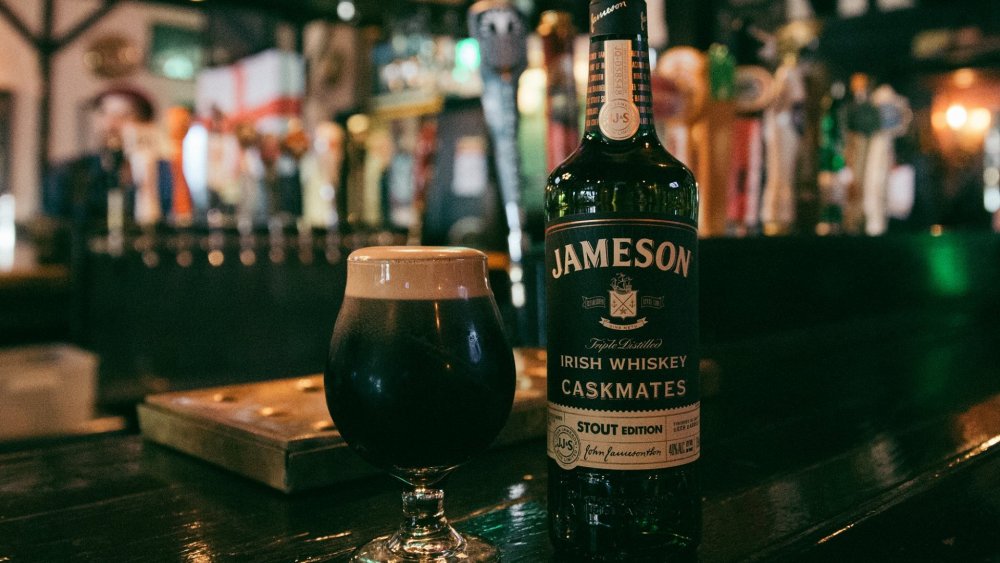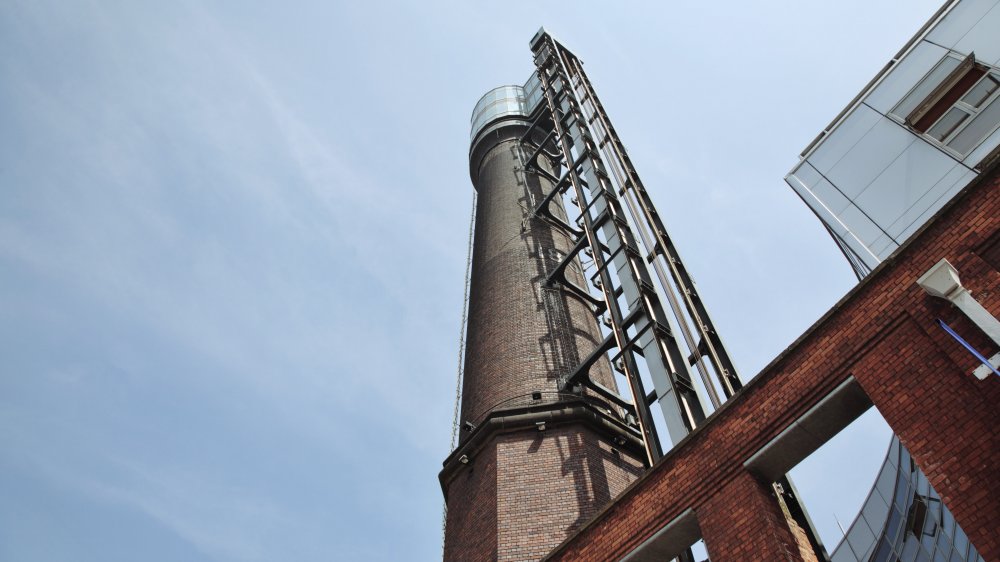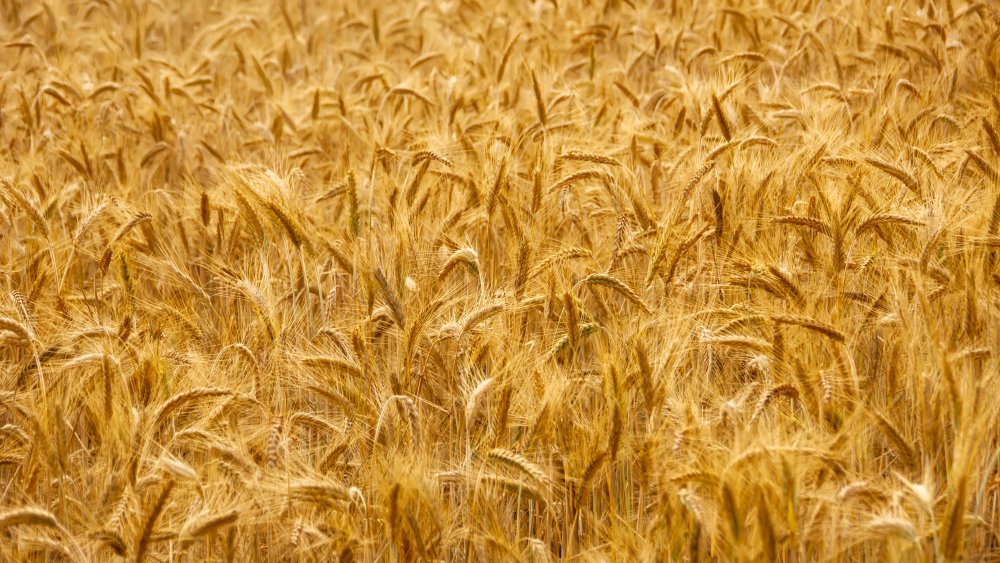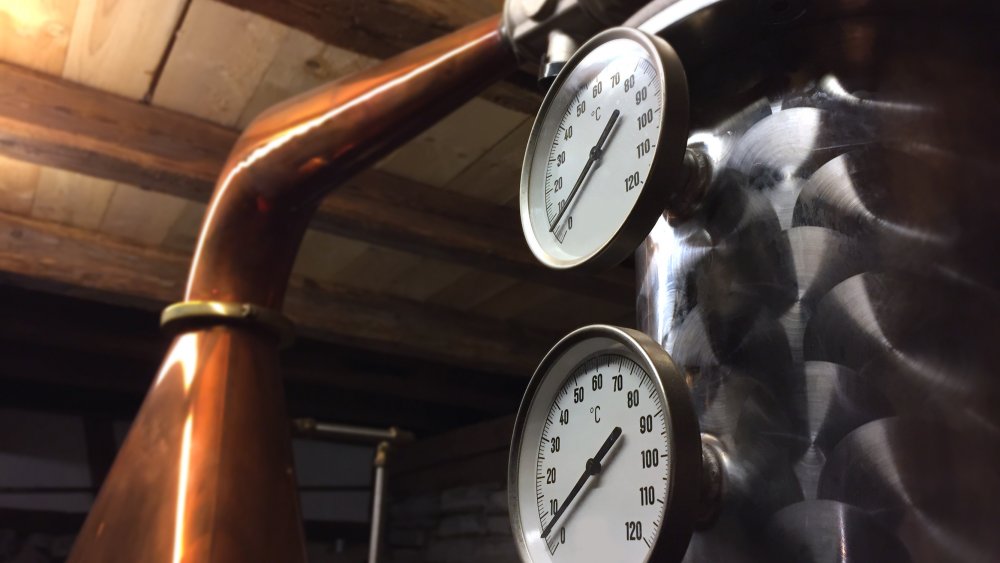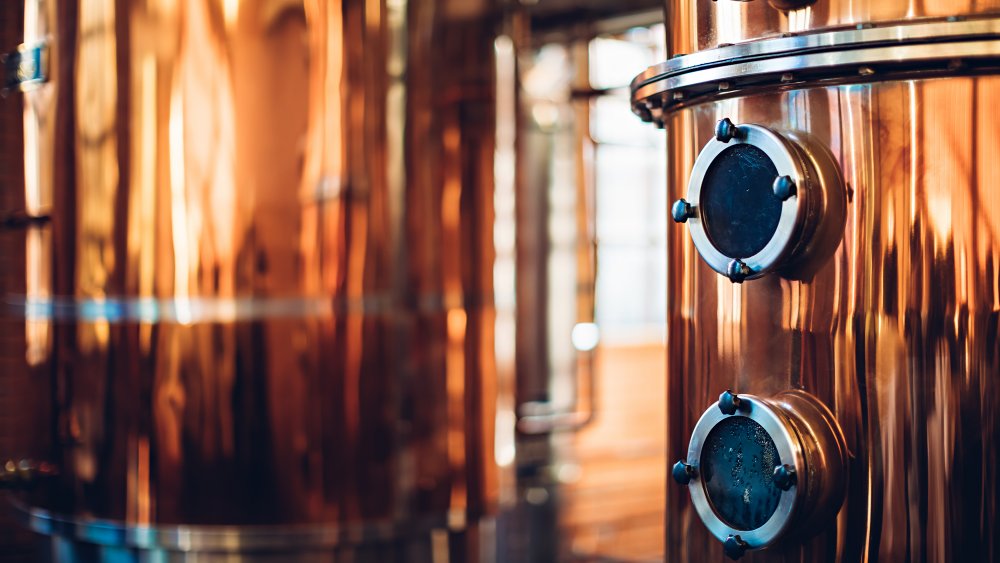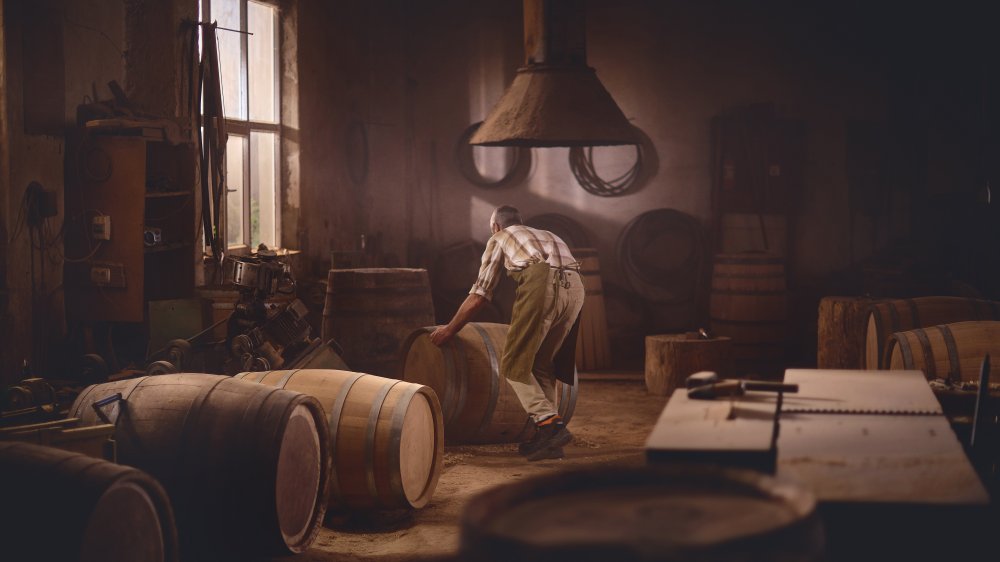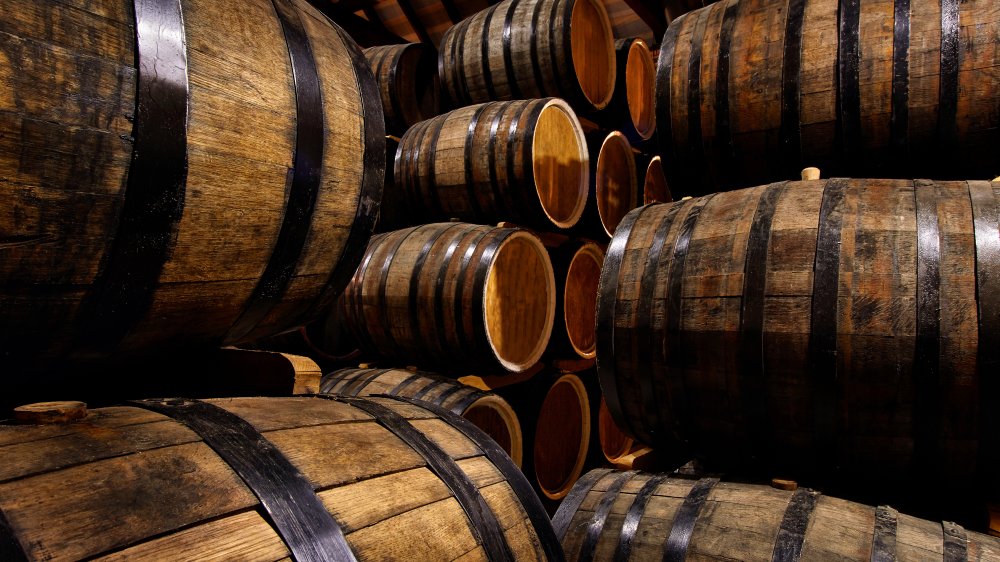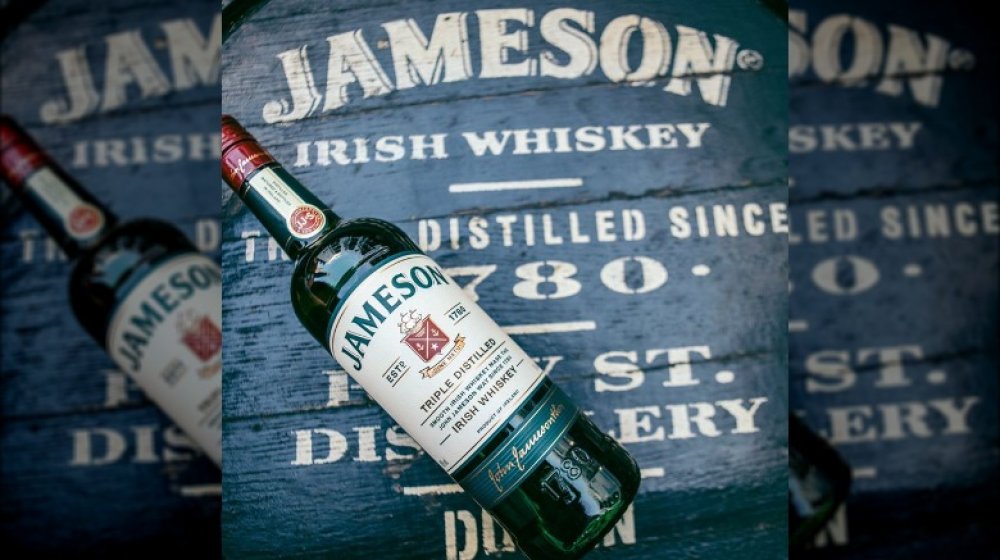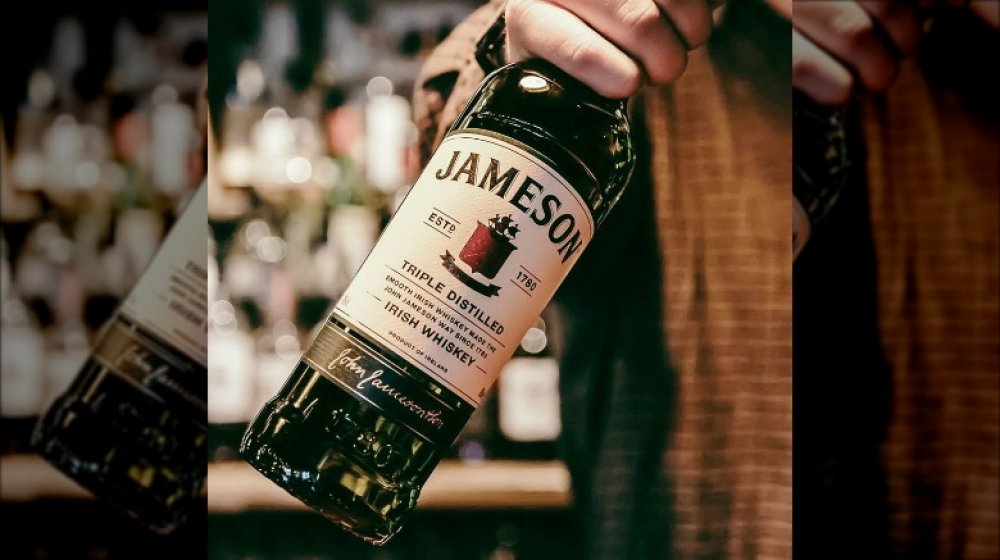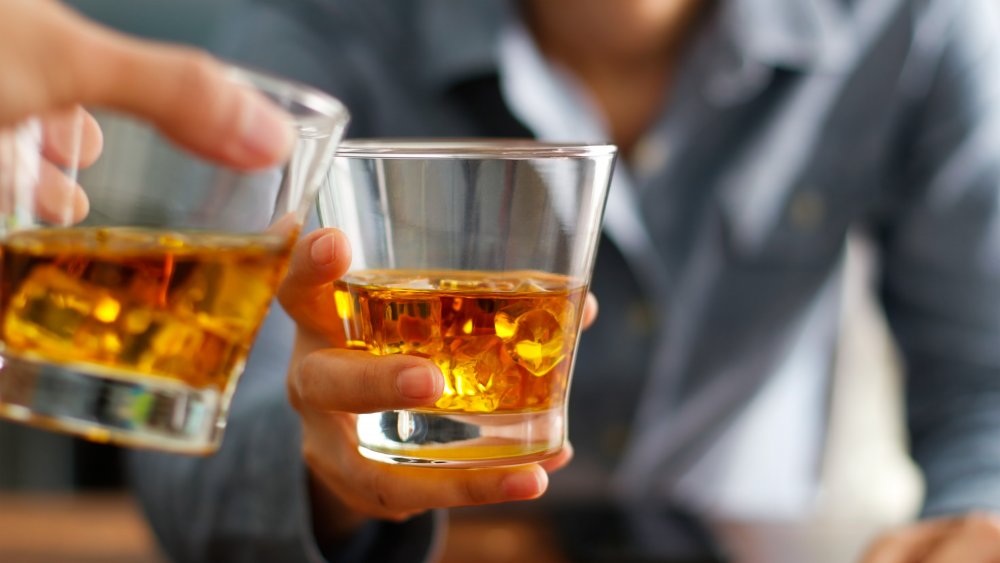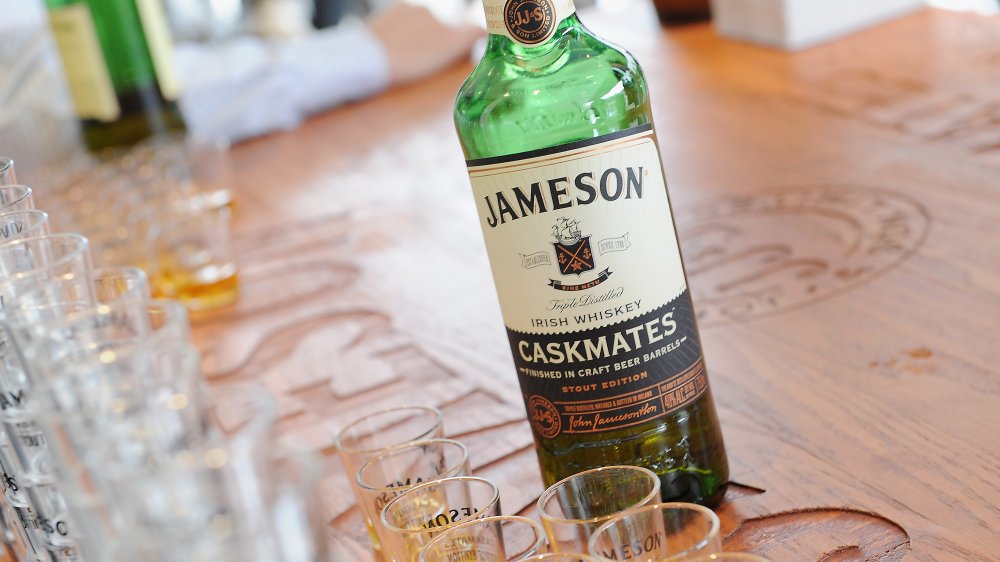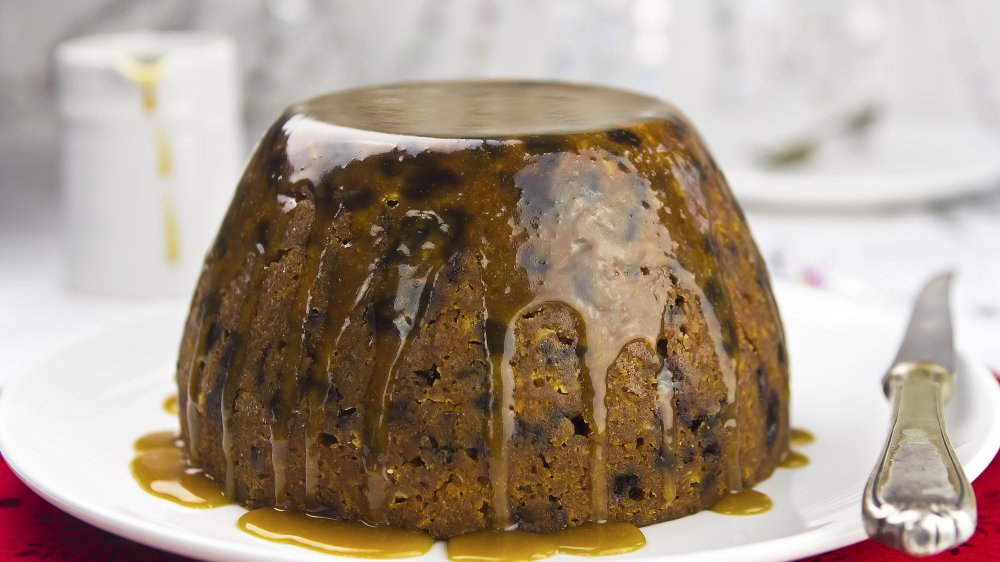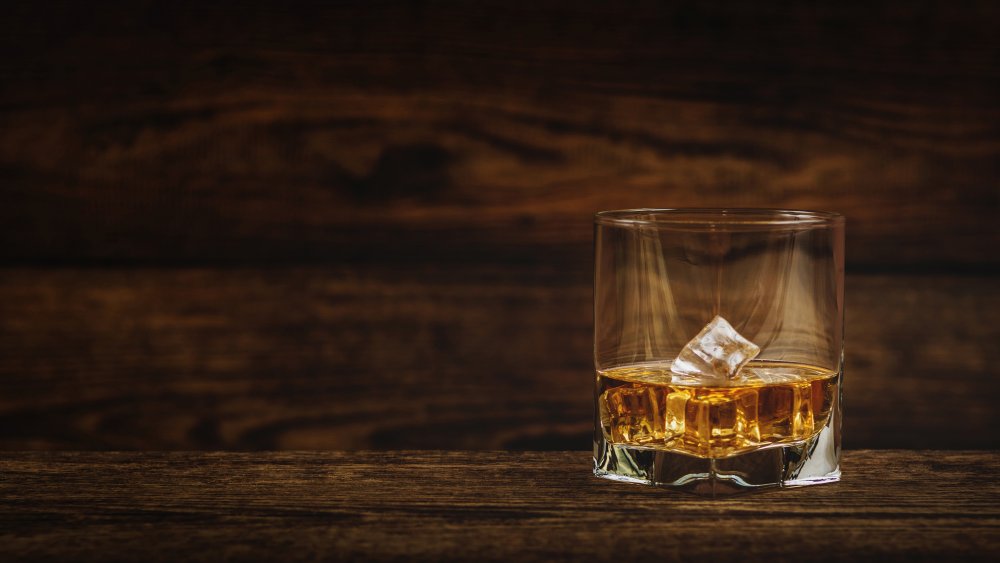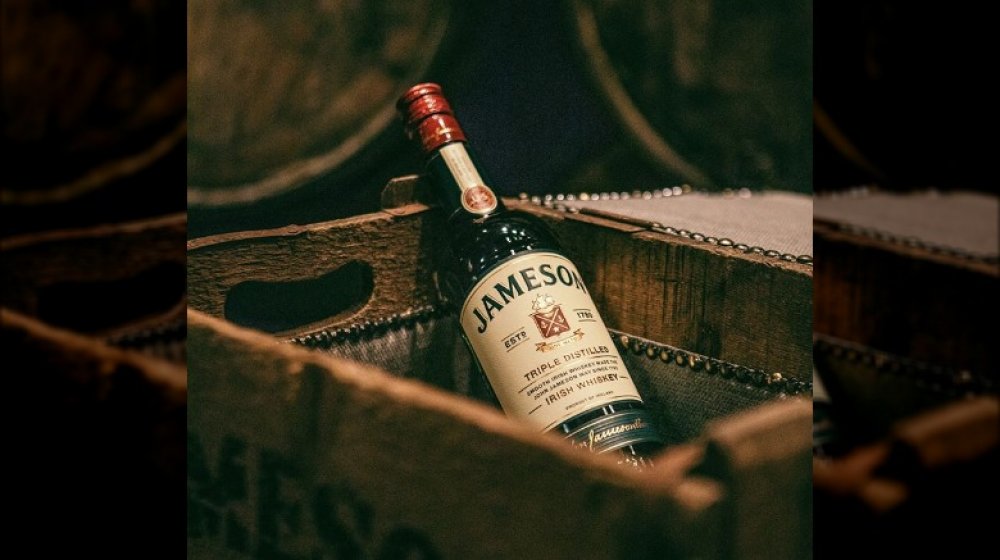The Untold Truth Of Jameson Irish Whiskey
When it comes to talking about whiskey, one vowel can make a huge distinction in the craft. In the late 1800s, Irish whiskey distilleries began to add an 'e' to the spelling of "whisky" to distinguish themselves from their competitors making scotch, and Jameson Irish Whiskey was certainly one to follow suit.
You've probably been introduced to Jameson Irish Whiskey a time or two if your typical bar order is an old fashioned, a whiskey sour, or whiskey neat. Or, maybe you've only tried this iconic Irish spirits brand during a night out with friends, celebrating Saint Patrick's Day with all of the classics for the day such as Jameson, Guinness, and even a pint of green beer. Either way, chances are, Jameson Irish Whiskey has been stocked behind every bar you've stepped foot in, offering up its smooth taste and unique oaky notes with a touch of vanilla. It's been a classic for years, a staple amongst whiskey aficionados and a great go-to for those who are just being introduced to the world of whiskey.
But what more is there to this crafted spirit than just a high ABV and the ability to easily drink it straight? We decided to dive in a little bit deeper and take a look. This is the untold truth of Jameson Irish Whiskey.
Jameson has been around for hundreds of years
If you've just turned 21, or you've only just begun to dive into the world of drinking whiskey, Jameson may seem completely new to you. But in reality, Jameson has been crafting Irish Whiskey for centuries.
It all began in Dublin, Ireland in 1780. Yes, really, it was that long ago. At the time, Bow Street, the area of Dublin in which Jameson was founded, was a popular spot for distilling whiskey, and the founder of Jameson decided it was his turn to make a mark on the land.
John Jameson, who was actually native to Scotland and spent the majority of his life working as a sheriff clerk, saw the opportunity at the time and decided to jump right in, leaving his job behind in Scotland and taking on the world of distilling. Since then, Jameson has held its ground, working to become one of the top whiskeys in the world over the course of its more than 200-year history.
Jameson Irish Whiskey starts with local grain
When it comes to making whiskey, it's a multiple-step process that requires careful calculation. But even before the process begins, it must be taken into account that great whiskey all begins with great ingredients.
As for Jameson's whiskey, it all starts with grain that is grown locally. As you can imagine, supplying the amount of grain Jameson needs to keep up production might be a huge undertaking for one farmer, so Jameson works with multiple farmers that are all located within 50 miles of the Middleton production site in Cork, Ireland. The grain is harvested in the later months of summer, and then part of it is malted, or toasted and germinated, to be used for production. Jameson actually uses a mixture of malted and unmalted barley, so only a portion of the barley goes through the malting process, eventually mixing both toasted and green barley with water to begin making this popular spirit.
Jameson uses a very specific water source
While it seems like water might not be all that important of an ingredient when it comes to distilling alcohol, it can actually change the product entirely. And that's why Jameson Irish Whiskey is quite particular about its water source.
When it comes to making whiskey, or any craft spirit or beer for that matter, regular tap water simply won't suffice. Water is added at the beginning of the distillation process to create the mash, and that's when sugars begin to be extracted and turned into alcohol. Once the distillation process is finished, water is often added to the cask after the product is fully matured to bring the alcohol proof down to its legal level. So, if the water isn't from a great source, or it imparts unwanted flavors, the end product has the potential to be ruined.
For Jameson, an incredibly local water source is used for distillation, bringing in water from the Dungourney River, which actually flows right through the distillery. You can't get much more local than that.
Jameson Irish Whiskey is distilled several times
While the ingredients that go into crafting spirits are quite similar, every liquor has a very specific distillation process, whether it's vodka, gin, bourbon, or Irish whiskey. And for Jameson Irish Whiskey, it may be even more specific, as the distillery has been triple-distilling its whiskey for hundreds of years.
Why distill alcohol three times? Well, it completely changes the texture of the drink, ultimately making it that much smoother to sip.
Once the malted and unmalted barley, and locally sourced water, are paired together to form a mash, the distillation process is just about ready to begin. Yeast is added to the mash to do its job, eating all of the sugar in the barley and turning it into alcohol, leaving distillers with what's called the wash. The wash is what's then put in the first still, allowing heat to be introduced, which ultimately separates parts of the liquid out that are less pure. Often, alcohols such as vodka that are usually consumed with mixers are only distilled once or twice. Jameson opted to distill their whiskey three times, resulting in the purest, smoothest possible product.
The casks are put together by hand
When we talk about putting whiskey in barrels, or casks, it's not just any old barrel. Distilleries don't just choose some sort of wooden crate, pour in the liquid, and call it a day. It all comes down to a specific science, and really, the majority of the flavor we get from Jameson Irish Whiskey is all thanks to the care and consideration that's put into choosing the barrel.
Jameson is aged in oak casks, and the oak plays a huge role in how the whiskey gets its complex flavors. But before the whiskey can even be put in a cask, the barrel has to be carefully put together.
Wooden barrels aren't constructed using glue, and they aren't put together with nails. These tools aren't used, because the flavor could be affected by introducing them to the wood, or the introduction of nails could potentially cause the barrel to leak. Much like American whiskey maker Jack Daniels, Jameson's barrels are put together by hand using perfectly measured staves of wood, all lined up with metal hoops that are slid over top. This creates the perfect, tight barrel to avoid any leakage.
Jameson must age for a specific amount of time to be considered Irish whiskey
Because of the history behind Irish whiskey, and the dedication those have to its craft, you really can't just throw any liquor in a bottle and call it Irish whiskey. There has to be some sort of standard to it.
There are multiple types of whiskey, including rye, scotch, and bourbon, and each has its own specific qualities. But for Irish whiskey and its qualifications, it all boils down to the aging process.
According to Whisky Advocate, for Irish whiskey to be considered true Irish whiskey, it has to follow everything laid out in the Irish Whiskey Act of 1980. There are requirements to follow such as making the whiskey with malted barley, distilling to 94.8 percent ABV or less, and bottling at nothing less than 40 percent ABV. But the requirements for aging is where the true standards for Irish whiskey come in.
Irish whiskey must be aged in wooden casks for at least three years, staying within the Republic of Ireland or Northern Ireland for the duration of the time. Furthermore, whiskey is not allowed to leave Ireland while in wooden casks, especially if keeping it in the cask is going to impart the qualities of additional aging. For Jameson, the amount of time spent in the cask differs for every batch, but at the very least, it's distilled for three years to live up to that requirement of being a true Irish whiskey.
You haven't always been able to get Jameson in a bottle
Heading to the grocery store to pick up the essentials, along with perhaps a bottle of whiskey for mixing up your favorite cocktails, has been pretty common practice for years. But it hasn't always been so accessible for fans of Jameson Irish Whiskey.
Despite its long, storied past, producing whiskey for hundreds of years, Jameson was only available by the cask, or barrel, for quite some time. The only way to enjoy a glass may have been to head to a local watering hole that had invested in a large cask, which typically holds 53 gallons of whiskey in the U.S.
Of course, when Jameson began in 1780, bottling was a far-fetched idea, but it was possible in the 1800s. However, the concept of bottling in glass was incredibly expensive for years, and perhaps the folks at Jameson just found that selling it by the cask was a better fit. Once 1968 rolled around, things finally changed. Jameson decided it was time to start bottling their coveted whiskey and finally started distributing Jameson by the bottle to liquor merchants.
The Jameson family motto is on the bottle
It's certainly not every day that a family can say they have their family motto printed on a bottle of whiskey, let alone a bottle that's shipped by the millions internationally. But members of the Jameson family certainly can.
If you look at a bottle of Jameson, you'll notice the family crest front and center on every single label. And if you look closer, under that crest you'll find the words "Sine Metu." Jameson's founder John Jameson brought that motto with him, which translates to "without fear," as it was passed down from his forefathers. As Jameson had taken a great leap of faith when he, a Scotsman, decided to open a whiskey distillery in Ireland, it seems fitting that this motto would live on in the Jameson family legacy. This is especially true with the family holding leadership positions under the same name — John Jameson — for decades following the distillery's founding batch.
Americans drink a lot of Jameson Irish Whiskey
You'd think that a distillery in Ireland would mainly catch the attention of its fellow Irish citizens, but that's not the case with Jameson. Yes, of course, there's plenty of whiskey to be consumed throughout Ireland, but when it comes to sales numbers in other countries, such as the United States, they're much higher than you might expect.
According to Forbes, Irish whiskey was the fastest-growing spirits category in the world, as the beverage reached a goal of selling 9.7 million cases internationally, outside of Ireland in 2017. During that year, Jameson contributed to one-third of those sales, selling more than three million cases. The same year, the category also saw an increase in sales of 10.6 percent, and the Irish Whiskey Association set its sights even higher, with a goal of 12 million cases for 2020 and 24 million cases for 2030.
And while those may seem like lofty goals, Americans are certainly helping to put a dent in those numbers. As of 2018, the United States was holding the spot for the number one importer of Irish Whiskey, next to Russia, after Americans spent $897 million on the spirit in 2017.
The Jameson distillery also works with American breweries
At first glance, it wouldn't seem that Jameson Irish Whiskey would have much in common with craft brewers in America. However, that's not the case.
In 2013, Jameson partnered up with Franciscan Wells, a micro-brewery based in Cork, Ireland. Jameson gave the brewery used casks to try out aging a stout beer, hoping the flavors of Irish Whiskey would be imparted on the final product. Once the aging process finished, the brewery returned the casks for Jameson to use for aging, allowing the flavors and aromas from the beer to be imparted onto the whiskey while aging. A beautiful relationship formed, and upon realizing that these two craft beverages worked well together the Caskmates program was introduced.
Since then, Jameson has continued to partner with breweries, launching its Caskmates program in America and pairing up with well-known craft breweries such as Bale Breaker Brewing Company, Angel City Brewery, and Great Divide Brewing Company. The brewers learn about the process of making Irish whiskey and then used Jameson barrels are shipped to the breweries for use when aging a beer. The used barrels are then returned to Jameson for a matching whiskey to be aged as well, producing two unique products through one strategic partnership.
You can bake with Jameson Irish Whiskey
If you're a huge Irish whiskey fan, then you know the flavor is unique and delicious. But what if you took that flavor and brought it to the table by baking with it? Talk about a total game-changer.
One traditional Irish dessert actually uses Jameson Irish Whiskey as its main flavoring ingredient. Irish whiskey cake has been a staple in Irish kitchens for decades, pairing a cake similar to pound cake with the flavors of Irish whiskey. The cake recipe utilizes whiskey in the batter, but it's the icing that really ups the alcohol content in this cake. The treat is traditionally topped with a simple glaze made from water and sugar, with six to eight tablespoons of Irish whiskey stirred in. And while it may seem like a cake covered in whiskey syrup is harmless, one slice or two will pack a punch.
Irish whiskey can also be a popular addition to mint chocolate chip cookies for a unique St. Patrick's Day theme or you can capture the flavor of whiskey and make an Irish whiskey cheesecake.
Jameson is ideal to enjoy neat or as a cocktail
Jameson Irish Whiskey has always had this certain allure to it, and part of that is how smooth the whiskey is to drink. Thanks to the fact that Jameson is distilled three times, it offers an incredibly approachable mouthfeel, compared to many other whiskey options that may seem a bit harsher on the palette.
Using Jameson in a cocktail, paired with simple ingredients, is a great way to mix up something flavorful, yet still light, for summer. Pairing Jameson with lime juice and citrus soda can make for a refreshing twist on the traditional Paloma, or you can use Jameson to make a simple Irish Whiskey and Tonic. Or, opt for something cozier for the colder months with Jameson, angostura bitters, and walnut bitters for an old fashioned.
And while Jameson works perfectly in cocktails, even serving as a great substitute in classic cocktail recipes, it's also the ideal sipper served up neat. Pour Jameson in a rocks glass without any other additions to sip and revel in its unique flavors.
Jameson is now owned by a French company
With the decades of history behind Jameson, it might be hard to believe that the distillery is not actually owned by an Irish company anymore. Of course, the production of Jameson still remains in Cork, Ireland, but it's been quite a few years since its ownership fell under the same country.
Jameson Irish Whiskey is owned by Pernod Ricard, a French spirits and wine company. Jameson has been under Pernod Ricard's purview since a deal for $442 million went through in 1988. Since then, Jameson has been in good company amongst other major spirits brands such as Absolut Vodka, Malibu, and Glenlivet, along with a number of other whiskey distilleries and wineries. And with Pernod Ricard's major distribution efforts and innovation dedicated toward the United States, it might stand to offer a reason why so much Jameson is sold and consumed in America.
